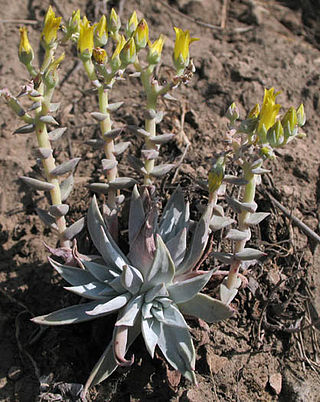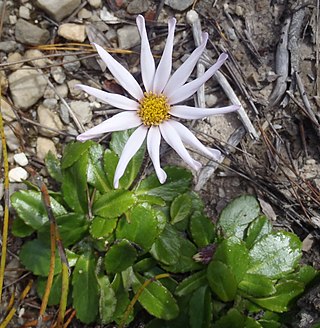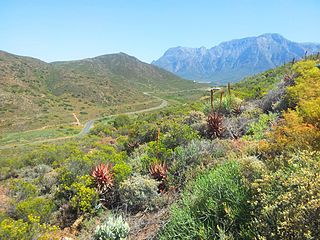
Stapelia is a genus of low-growing, spineless, stem succulent plants, predominantly from South Africa with a few from other parts of Africa. Several Asian and Latin American species were formerly included but they have all now been transferred to other genera. The flowers of certain species, most notably Stapelia gigantea, can reach 41 cm (16 inches) in diameter when fully open. Most Stapelia flowers are visibly hairy and generate the odor of rotten flesh when they bloom.

Gasteria is a genus of succulent plants, native to South Africa and the far south-west corner of Namibia.

Cotyledon is one of some 35 genera of succulent plants in the family Crassulaceae. Mostly from Southern Africa, they also occur throughout the drier parts of Africa as far north as the Arabian Peninsula. Ten of its species are mostly confined to South Africa, where unlike Tylecodon, they occur commonly in both the winter and summer rainfall regions. They may be found on coastal flats and rocky hillsides, or as cremnophytes on cliff faces. Their decussate, evergreen leaves are very variable in shape, even within some species, but the flowers are, apart from colour, very similar.

Duvalia is a succulent plant genus in the subfamily Asclepiadoideae, in the family Apocynaceae (dogbane).

Dudleya caespitosa is a succulent plant known by several common names, including sea lettuce, sand lettuce, and coast dudleya. It is endemic to California, where it grows along the coastline in the southern half of the state. Taxonomically, this species is a highly variable complex of polymorphic and polyploid plants, closely related to numerous neighboring species such as Dudleya farinosa, Dudleya greenei and Dudleya palmeri. It is delimited from neighboring species on an arbitrary basis of distribution and chromosome number, and may not be immediately separable from the other species it approaches.

Dudleya farinosa is a species of succulent plant in the family Crassulaceae known by several common names, including bluff lettuce, powdery liveforever, and powdery dudleya. A coastal plant of northern California and southern Oregon, it is typically found on oceanic bluffs just directly above the reach of the waves. Its appearance is characterized by lotus-like rosettes of beveled leaves, and in summer the plant erects a tall pink to red stem densely covered in foliage, topped with branches adorned with pale yellow flowers. The green or white rosettes of this plant can be seen covering stretches of rocky coast and nearby islets.

Dudleya verityi is a rare species of succulent plant known by the common name Verity's liveforever. It is endemic to Ventura County, California, where it is known from only three occurrences in the vicinity of Conejo Mountain between Camarillo and Thousand Oaks. It probably occurs in a few additional locations nearby which have not yet been officially vouchered.

Mairia is a genus of perennial herbaceous plants assigned to the family Asteraceae. All species have leathery, entire or toothed leaves in rosettes, directly from the underground rootstock, and one or few flower heads sit at the top of the stems that carry few bracts. These have a whorl of white to mauve ray florets surrounding yellow disc florets in the centre. In general, flowering only occurs after the vegetation has burned down. The six species currently assigned to Mairia are endemic to the Western Cape and Eastern Cape provinces of South Africa. Some of the species are called fire daisy in English and vuuraster in Afrikaans.

Microloma is a small genus of Ceropegia-like twiners and twiggy bushes occurring in mainly arid or fynbos regions in South Africa. They are generally nondescript when not in bloom, but the flowers of most species are incongruously decorative.

Stapeliopsis is a genus of succulent plants in the family Apocynaceae, native to southern Africa.

Piaranthus is a succulent plant genus in the subfamily Asclepiadoideae, in the family Apocynaceae.

Robertson Karoo is a semi-arid vegetation type, restricted to sections of the Breede River Valley, Western Cape Province, South Africa. It is a subtype of Succulent Karoo and is characterised by the dominance of succulent plant species, and by several endemic plants and animals.

Mairia coriacea is a perennial plant assigned to the family Asteraceae. It has broad, tough and leathery, evergreen leaves. These have a narrowed foot and an entire margin or a few shallow, irregular teeth. They grow in a rosette directly from the rootstock. The plant produces flower heads with one whorl of white to mauve ray florets around many yellow disc florets, with one or few on top of a dark reddish, woolly stalk. Flower heads appear after the overhead vegetation burnt down, often destroying the leaves in the process. It can be found in the southern mountains of South Africa's Western Cape province. It is called leather leaves in English.
Felicia annectens is an annual plant of up to about 25 cm (10 in) high, that is assigned to the family Asteraceae. The lower leaves are opposite and the higher leaves alternate. The bloated involucre consists of very broad, hairless bracts. These protect up to ten, short, bluish ray florets that encircle yellow, partly sterile disc florets. The heads sit individually on top of up to 6 cm long stalks. The species was considered extinct after no observations were made after 1915, but was rediscovered in the 21st century. It occurs in the Western Cape province of South Africa.

Felicia tenella is an annual, sometimes biennial, herbaceous plant that may be slightly woody at its base, of 5–70 cm tall, that is assigned to the family Asteraceae. The species is very variable in size and hairiness. Its branches may be erect or ascending, and the leaves are narrowly line-shaped, 2–5 cm long and about 1 mm (0.04 in) wide. The leaves have a callous tip, lack visible nerves, and are mostly rigidly ciliate. The flower heads sit individually at the tip of stalks, have an involucre of three whorls of bracts, and about thirty light blue ray florets surrounding many yellow disc florets. Four subspecies are recognised. The species naturally occurs in the Northern Cape and Western Cape provinces of South Africa.

Trichodiadema pygmaeum is succulent plant of the genus Trichodiadema, native to the Western Cape Province, South Africa, where it is found in fine-grained soils in the regions of Bredasdorp and Swellendam.

Duvalia caespitosa is a small succulent plant species, in the family Apocynaceae, widespread in South Africa.

Duvalia vestita is a small succulent plant species, in the family Apocynaceae, indigenous to the southernmost part of the Western Cape Province, South Africa.
Curio corymbifer, synonyms including Senecio corymbifer and Senecio sarcoides, is a species of succulent flowering plant in the aster family Asteraceae, indigenous to the Cape Provinces of South Africa, Namibia and Swaziland.

Selago ramosissima is a species of plant in the family Scrophulariaceae. It is endemic to the Western Cape, South Africa.




















